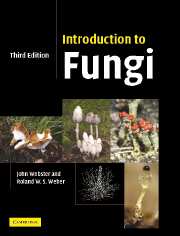Book contents
- Frontmatter
- Contents
- Preface to the first edition
- Preface to the second edition
- Preface to the third edition
- Acknowledgements
- 1 Introduction
- 2 Protozoa: Myxomycota (slime moulds)
- 3 Protozoa: Plasmodiophoromycota
- 4 Straminipila: minor fungal phyla
- 5 Straminipila: Oomycota
- 6 Chytridiomycota
- 7 Zygomycota
- 8 Ascomycota (ascomycetes)
- 9 Archiascomycetes
- 10 Hemiascomycetes
- 11 Plectomycetes
- 12 Hymenoascomycetes: Pyrenomycetes
- 13 Hymenoascomycetes: Erysiphales
- 14 Hymenoascomycetes: Pezizales (operculate discomycetes)
- 15 Hymenoascomycetes: Helotiales (inoperculate discomycetes)
- 16 Lichenized fungi (chiefly Hymenoascomycetes: Lecanorales)
- 17 Loculoascomycetes
- 18 Basidiomycota
- 19 Homobasidiomycetes
- 20 Homobasidiomycetes: gasteromycetes
- 21 Heterobasidiomycetes
- 22 Urediniomycetes: Uredinales (rust fungi)
- 23 Ustilaginomycetes: smut fungi and their allies
- 24 Basidiomycete yeasts
- 25 Anamorphic fungi (nematophagous and aquatic forms)
- References
- Index
- Plate section
14 - Hymenoascomycetes: Pezizales (operculate discomycetes)
- Frontmatter
- Contents
- Preface to the first edition
- Preface to the second edition
- Preface to the third edition
- Acknowledgements
- 1 Introduction
- 2 Protozoa: Myxomycota (slime moulds)
- 3 Protozoa: Plasmodiophoromycota
- 4 Straminipila: minor fungal phyla
- 5 Straminipila: Oomycota
- 6 Chytridiomycota
- 7 Zygomycota
- 8 Ascomycota (ascomycetes)
- 9 Archiascomycetes
- 10 Hemiascomycetes
- 11 Plectomycetes
- 12 Hymenoascomycetes: Pyrenomycetes
- 13 Hymenoascomycetes: Erysiphales
- 14 Hymenoascomycetes: Pezizales (operculate discomycetes)
- 15 Hymenoascomycetes: Helotiales (inoperculate discomycetes)
- 16 Lichenized fungi (chiefly Hymenoascomycetes: Lecanorales)
- 17 Loculoascomycetes
- 18 Basidiomycota
- 19 Homobasidiomycetes
- 20 Homobasidiomycetes: gasteromycetes
- 21 Heterobasidiomycetes
- 22 Urediniomycetes: Uredinales (rust fungi)
- 23 Ustilaginomycetes: smut fungi and their allies
- 24 Basidiomycete yeasts
- 25 Anamorphic fungi (nematophagous and aquatic forms)
- References
- Index
- Plate section
Summary
Introduction
The order Pezizales contains the operculate discomycetes which are the most readily recognized cup fungi. The order is large, containing some 15 families, about 160 genera and over 1100 species (Kirk et al., 2001). Most are terrestrial and saprotrophic on soil, burnt ground, decaying wood, compost or dung, but some form sheathing mycorrhiza (ectomycorrhiza) with trees (Maia et al., 1996). A somewhat exceptional case is Rhizina undulata, which causes root rot of conifers in plantation situations, usually starting from areas affected by recent fires (Callan, 1993). Whilst most species of Pezizales produce epigeous fruit bodies above ground level and have active ascus discharge mechanisms with wind-dispersed ascospores, the truffles (e.g. Tuber and Terfezia) form subterranean (hypogeous) ascomata. The dispersal of truffles relies on the ripe ascomata being eaten by rodents and other mammals attracted by their strong odour. The ascospores survive digestion and defaecation. There are also aquatic Pezizales, growing on wood in streams or other wet places. An overview of the Pezizales may be found in Pfister and Kimbrough (2001). Keys to genera are given by Korf (1972) and Dissing et al. (2000).
The ascocarp is generally an apothecium (p. 245) which can range in diameter from less than one millimetre to several centimetres. It is often cup-shaped or disc-like, fleshy, sometimes stalked, and frequently brightly coloured. The asci are, in most cases, cylindrical with a well-defined lid called operculum (see pp. 239–241) which is the characteristic feature of the Pezizales.
- Type
- Chapter
- Information
- Introduction to Fungi , pp. 414 - 428Publisher: Cambridge University PressPrint publication year: 2007



